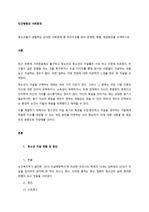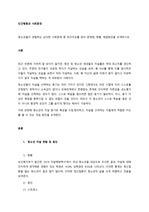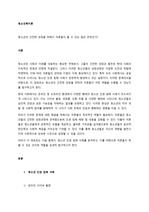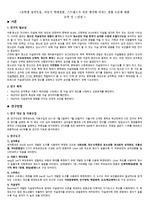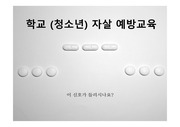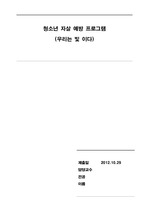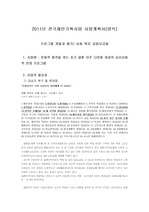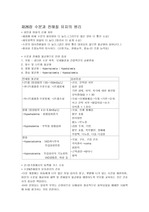

BRONZE
BRONZE 등급의 판매자 자료
[정신분석]긍정적 정서함양이 자아 존중감, 스트레스 및 우울에 미치는 효과
본 연구의 목적은 긍정적 정서 함양이 대학생들의 자아존중감, 스트레스, 그리고 우울회복에 미치는 효과를 검증하는 것이다.
본 연구의 가설 검증을 위한 실험에 참석한 인원은 총41명이었다. 연구의 통계를 검증을 위해 이원변량분석을 실시하였고, 실험을 위해 이용된 척도는 Beck 의 우울척도, Rosenberg의 자아존중감 척도, 최혜림의 스트레스 대처 척도, 그리고 Diener, Smith, & Fujita의 정서 경험 강도 척도이다.
73 페이지
최초등록일 2006.02.09
최종저작일
2005.01
![[정신분석]긍정적 정서함양이 자아 존중감, 스트레스 및 우울에 미치는 효과](https://image4.happycampus.com/Production/thumb212/2006/02/09/data4100235-0001.jpg)
-
미리보기
소개
본 연구의 목적은 긍정적 정서 함양이 대학생들의 자아존중감, 스트레스, 그리고 우울회복에 미치는 효과를 검증하는 것이다.
본 연구의 가설 검증을 위한 실험에 참석한 인원은 총41명이었다. 연구의 통계를 검증을 위해 이원변량분석을 실시하였고, 실험을 위해 이용된 척도는 Beck 의 우울척도, Rosenberg의 자아존중감 척도, 최혜림의 스트레스 대처 척도, 그리고 Diener, Smith, & Fujita의 정서 경험 강도 척도이다.목차
Ⅰ. 서 론
1. 문제의 제기
2. 연구의 목적 및 가설
Ⅱ. 이론적 배경
1. 긍정적 정서의 함양
1) 긍정적 의미의 발견
2) 인지의 확장
3) 자원의 형성
4) 확장 - 형성(Broaden & Build) 이론과 소거효과
2. 긍정적 정서함양의 효과
1) 긍정적 정서 강도의 변화
2) 자아존중감
3) 스트레스
4) 우울증
Ⅲ. 연구 방법
1. 연구대상
2. 긍정적 정서 함양 프로그램
3. 측정도구
4. 연구설계
5. 연구절차
6. 자료의 분석
Ⅳ. 연구 결과
1. 긍정적 정서 경험 효과
2. 자아존중감 효과
3. 스트레스효과
4. 우울증효과
Ⅴ. 논 의
Ⅵ. 결론 및 제언
참고문헌
부록 1. 긍정적 정서 함양 프로그램
부록 2. 정서 경험 강도척도
부록 3. 자아 존중감 척도
부록 4. 스트레스 질문지
부록 5. 우울척도본문내용
1. 문제의 제기
상담 현장에서 보면, 내담자들은 자아 존중감의 결여, 우울증상, 불안상태, 스트레스의 누적 및 고독감의 증가와 같은 문제를 지니고 있다. 이들 문제는 자신을 부정적으로 지각하고 해석함으로써 발생한다고 볼 수 있다. 또한 상담자들은 내담자의 부정적 정서를 제거하기 위한 노력을 하지만 그럼에도 불구하고 내담자들이 상담이 종결된 이후에도 여전히 해결되지 못하는 사례가 빈번하다. 대부분의 사람들이 일상생활 속에서 부정적 정서를 경험하는 것은 불가피한 일이지만 부정적 정서에서 생긴 고통이나 상실 등의 감정을 이해하고, 그 문제를 해결하는 일은 중요하고도 시급한 사안이다(Fredrickson, 2000a).
Frederickson(1998)은 인간의 잠재력 가운데서 대체로 개발되지 않은 채로 남아 있는 긍정적 정서를 이용하는 것이 부정적 정서에서 발생되는 문제에 대한 적극적인 해결책이라고 주장하고 있다. 그 이유는 부정적 정서의 지각은 쉬우나 긍정적 정서는 그 양이 적고 광범위하다는 가정에 기인한다(Ellsworth & Smith, 1988; de Rivera, Possell, Verette, & Weiner, 1989; Fredrickson, 1998 ). 많은 연구자는 부정적 정서를 제거 또는 치료하기 위한 다양한 기법을 적용하였지만 긍정적 정서를 함양하는 적극적인 기법의 활용에는 소극적이었다.
Frederickson(1998)은 긍정적 정서가 연구되지 않은 이유를 두가지로 정리 하였다. 첫째, 심리학의 초점이 내담자의 문제 발견과 그 해결에 초점을 두고 있었기에 부정적 정서에 비해 긍정적인 정서를 상대적으로 경시했다. 부정적 정서를 연구함으로 사회나 개인이 가진 많은 문제를 해결하였다. 예를 들어, 화는 심장병(Barefoot, Dahlstrom, & Williams, 1983) 그리고 암, 공격성, 폭력에 나쁘고, 두려움과 불안은 공포를 낳고(Ohman, 1993), 슬픔은 우울(Nolen-Hoeksema, Morrow & Frederickson, 1993)과 습식 장애(Silberstein, Striegel-Moore & Rodin, 1987)를 가져다 준다는 사실들을 확인하였다. 이처럼 부정적 정서에 대한 연구는 실제적으로 사회 속에서 발생한 수많은 사회 문제들을 해결다. 그러나 대부분의 연구가 부정적인 측면을 강조하였기에 인간의 적응 능력이나 건강등의 긍정적인 부분에 대한 균형 잡힌 시각을 두어온 것은 아니다. 단지 우울에 대한 긍정적 정서의 효과(Davidson, 1993)나, 약물남용에 대한 긍정적 정서의 효능(Nesse & Berridge, 1997)처럼 매우 재한적으로 연구 되었다. 즉 부정적 정서를 제거하기 위한 연구에는 적극적이었지만 긍정적 정서에 관한 연구는 소극적이었다.참고자료
· 참 고 문 헌
· 김광수 (1999). 용서교육 프로그램 개발. 서울대학교 대학원 박사학위논문.
· 김광운 (2002). 스트레스 요인과 우울정도와의 관계분석. 수원대학교 대학원 석사 학위논문.
· 박혜진 (2003). 자기애, 자기효능감, 자의식 및 우울간의 관계. 아주대학교 대학원 석사학위논문.
· 송달호 (2001). 자아존중감, 통제소재, 실패내성이 아동의 스트레스 대처 행동에 미치는 영향. 이화여자 대학교 대학원 석사학위논문.
· 안신호, 박두진 (2000). 한국의 정서 및 동기심리학 연구 : 개관 및 문헌 정리. 심 리과학연구지, 1(1), 119-154.
· 오오현 (2001). 기독교인 용서상담 프로그램 개발 및 효과검증. 계명대학교 박사 학위 청구논문.
· 오지원 (2000). 자존감과 고독감 및 스트레스가 대학생의 폭식습관에 미치는 영 향. 가톨릭대학교 심리상담대학원 석사학위논문.
· 이훈구 (1997). 행복의 심리학 : 주관적 안녕. 서울 : 법문사.
· 최혜림 (1986). 한국 대학생의 스트레스 현황과 인지 행동적 상담의 효과. 이화여 자 대학교 박사학위논문.
· 한영숙 (2004). 긍정적 자아 정체감과 자존감을 위한 사랑의 구성요소와 유형에 대한 연구. 고신대학교 대학원 석사학위논문.
· 홍혜영 (1995). 완벽주의 성향, 자기효능감, 우울간의 관계연구. 이화여자 대학교 석사학위논문.
· Affeck, G., & Tennen, H. (1996). Construing benefits from adversity: Adaptational significance and dispositional underpinnings. Journal of Personality, 64, 899-922.
· Barefoot, J. C., Dahlstrom, W. G., & Williams, R. B. (1983). Hostility, CHD incidence, and total mortality: A 25-year follow-up study of 255 physicians. Psychosomatic Medicine, 45, 59-63.
· Batson, C. D., Ahmad, N., Lishner, D., & Tsang, J. (2002). Empathy and altruisum. In C. R. Synder & S. Lopez (Eds.), The handbook of positive psychology (pp. 485-498). New York: Oxford University Press.
· Baumeister, R. F. (1991). Meanings of Life. New York: Guilford Press.
· Baumeister, R. F., & Vohs, K. D., Bratslavsky, E., & Finkenauer, C. (2000). Bad is stronger than good. In C. R. Synder & S. Lopez (Eds.), The handbook of positive psychology (pp. 608-618). New York: Oxford University Press.
· Cassell, E. (2002). Compassion. In C. R. Synder & S. Lopez (Eds.), The handbook of positive psychology (pp. 434-445). New York: Oxford University Press.
· Compton, W. C. (2005). Introduction to Positive Psychology. Belmont, TN: Middle Tennessee State University.
· Davidson, R. J. (1993). The neuropsychology of emotion and affective style. In M. Lewis & J. M. Haviland (Eds.), Handbook of emotion (pp. 143-154). New York: Guilford Press.
· Davis, C. G., Nolen-Hoeksema, S., & Larson, J. (1998). Making sense of loss and benefiting from experience: Two construals of meaning. Journal of Personality and Social Psychology, 75, 561-574.
· de Rivera, J., Possel, L., Verette, J. A., & Weiner, B. (1989). Distinguishing elation, gladness, and joy. Journal of Personality and Social Psychology, 57, 1015-1023.
· Diener, E., Smith, H., & Fujita, F. (1995). The personality structure of affect. Journal of Personality and Social Psychology, 50, 130-141.
· Ekman, P., Friesen, W. V., O`Sullivan, M., Chan, A., Diacoyanni-Tarlatzis, I., Heider, K., Krause, R., LeCompre, W. A., Ritcairn, T., Ricci-Bitti, P. E., Scherer, K., Tomita, M., & Tzavras, A. (1987). Universals and cultural differences in the judgments of facial expressions of emotions. Journal of Personality and Social Psychology, 53, 712-717.
· Ellsworth, P. C., & Smith, C. A. (1988). Shades of joy: Patterns of appraisal differentiating pleasant emotions. Cognition and Emotion, 2, 301-331.
· Emmons, R. A., & Shelton, C. (2002). Gratitude and the science of positive psychology. In C. R. Synder & S. Lopez (Eds.), The handbook of positive psychology (pp. 495-471). New York: Oxford University Press.
· Esterling, B. A., L`Abate, L., Murray, E. J., & Pennebaker, J. W. (1999). Empirical foundations for writing in prevention and psychotherapy: Mental and physical health outcomes. Clinical Psychology Review, 19, 79-96.
· Estrada, C. A., Isen, A. M., & Young, M. J. (1997). Positive affect facilitates integration of information and decreases anchoring in reasoning among physicians. Organizational Behavior and Human Decision Processes, 72, 117-135.
· Eysenck, H. J. (1994). Genius-The natural history of creativity. Cambridge, England: Cambridge University Press.
· Folkman, S. (1997). Positive psychological states and coping with severe stress. Social Science Medicine, 45, 1207-1221.
· Folkman, S., Chesney, M. A., Collette, L., Boccellari, A., & Cooke, M. (1996). Post-bereavement depressive mood and its pre- bereavement predictors in HIV+ and HIV- gay men. Journal of Personality and Social Psychology, 70, 336–348.
· Frankl, V. E. (1959). Man`s search for meaning: An introduction to logotherapy. New York: Simon & Schuster.
· Fredrickson, B. L. (1998) What good are positive emotion. Review of General Psychology, 2, 300-319.
· Fredrickson, B. L. (2000a). Cultivating positive emotions to optimize health and well-being. Prevention and Treatment, 3. Retrieved August 22, 2005, from http://www.journals.apa.org/prevention.
· Fredrickson, B. L. (2000b). Extracting meaning from past affective experiences: The importance of peaks, ends, and specific emotions. Cognition and Emotion, 14, 577-606.
· Fredrickson, B. L. (2000c). Why positive emotion matter in organization: Lessons from the broaden-and-build model. The Psychologist
· -Manager Journal, 4, 131-142.
· Fredrickson, B. L. (2001). The role of positive emotions in positive psychology: The broaden-and-build theory of positive emotions. American Psychologist, 56, 218-226.
· Fredrickson, B. L. (2002). Positive emotions. In C. R. Snyder & S. J. Lopez (Eds.), The handbook of positive psychology (pp. 120-134). New York: Oxford University Press.
· Fredrickson, B. L., & Joiner, T. (2002). Positive emotions trigger upward spirals toward emotional well-being. Psychological Science, 13, 172-175.
· Fredrickson, B. L., & Levenson, R. W. (1998). Positive emotions speed recovery for the cardiovascular sequel of negative emotion. Cognition and Emotion, 12, 191-220.
· Fredrickson, B. L., & Mancuso, R. A., Branigan, C., & Tugade, M. M. (2000). The undoing effect of positive emotions. Motivation and Emotion, 24, 237-258.
· Fredrickson, B. L., Tugade, M. M., Waugh, C. E., & Larkin, G. R. (2003). What good are positive emotions in crises? A prospective study of resilience and emotions following the terrorist attacks on the United States on September 11th, 2001. Journal of Personality and Social Psychology, 84, 365-376.
· Heatherton, T. F., & Nichols, P. A. (1994). Personal accounts of successful versus failed attempts at life change. Personality and Social Psychology Bulletin, 20, 664-675.
· Hendrick, S. S., & Hendrick, C. (1992). Romantic love. Newbury Park, CA: SAGE Publications.
· Hoyle, R., Kernis, M., Leary, M., & Baldwin, M. (1999). Selfhood: Identity, esteem, regulation. Boulder, CO: Westview Press.
· Isen, A. M., & Baron, R. A. (1991). Positive affect in organizations. Research in Organizational Behavior, 13, 1-52.
· Isen, A. M., & Daubman, K. A. (1984). The influence of affect on categorization. Journal of Personality and Social Psychology, 47, 1206-1217.
· Isen, A. M., Daubman, K. A., & Nowicki, G. P. (1987). Positive affect facilitates creative problem solving. Journal of Personality and Social Psychology, 52, 1122-1131.
· Isen, A. M., Johnson, M. M. S., Mertz, E., & Robinson, G. F. (1985). The influence of positive affect on the unusualness of word associations. Journal of Personality and Social Psychology, 48, 1413-1426.
· Isen, A. M., Rosenzweig, A. S., & Young, M. J. (1991). The influence of positive affect on clinical problem solving. Medical Decision Making, 11, 221-227.
· Kahn, B. E., & Isen, A. M. (1993). The influence of positive affect on variety seeking among safe, enjoyable products. Journal of Consumer Research, 20, 257-270.
· Lazarus, R. S. (1991). Emotion and adaption. Journal of Organizational Change Management, 7, 24-41.
· Lazarus, R. S., & Folkman, S. (1984). Stress, appraisal, and coping. New York: Springer.
· Lucas, R. E., Diener, E., & Larsen, R. J. (2003). Measuring positive emotions. In S. J. Lopez & C. R. Snyder (Eds.), Positive psychological assessment - A Handbook of models and measures (pp. 201-218) Washington, DC: American Psychological Association.
· Lyubomirsky, S., & Tucker, K. L.(1998). Implications of individual differences in subjective happiness for perceiving, interpreting, and thinking about life event. Motivation and Emotion, 22, 155-186.
· McAdams, D. P., Diamond, A., de St. Aubin, E., & Mansfield, E. (1997). Stories of commitment: The psychosocial construction of generative lives. Journal of Personality and Social Psychology, 72, 678-694.
· Nesse, R. M., & Berridge, K. C. (1997). Psychoactive drug use in evolutionary perspective. Science, 278, 63-66.
· Nolen-Hoeksema, S., Morrow, J., & Fredrickson, B. L. (1993). Response styles and the duration of episodes of depressed mood. Journal of Abnormal Psychology, 102, 20-28.
· Ohman, A. (1993). Fear and anxiety as emotional phenomena: Clinical phenomenology, evolutionary perspectives, and information-
· processing mechanisms. In M. Lewis & J. M. Haviland (Eds.), Handbook of emotions (pp. 511-536). New York: Guilford Press.
· Park, C. L., & Folkman, S. (1997). Meaning in the context of stress and coping. Review of General Psychology, 1(2), 115-144.
· Pennebaker, J. W. (1993). Putting stress into words: Health, linguistic, and therapeutic implications. Behavioral Research and Therapy, 31, 539-548.
· Pennebaker, J. W., & Francis, M. E. (1996). Cognitive, emotional, and language processes in disclosure. Cognition and Emotion, 10, 601-626.
· Rosenberg, M. (1965). Society and the adolescence self-image. Princeton, NJ: Priceton University Press.
· Ryan, R. M., & Deci, E. L. (2000). Self-determination theory and the facilitation of intrinsic motivation, social development, and well-being. American Psychologist, 55, 68-78.
· Scheier, M. F., & Carver, C. S. (1992). Effects of optimism on psychological and physical well-being: Theoretical overview and empirical update. Cognitive Therapy and Research, 16, 201-228.
· Seidlitz, L., Wyer, R. S., & Diener, E. (1997). Cognitive correlates of subjective well-being: The processing of valenced life events by happy and unhappy persons. Journal of Research in Personality, 31, 240-256.
· Silberstein, L. R., Striegel-Moore, R., & Robin, J. (1987). Feeling fat: A woman`s shame. In H. B. Lewis (Eds.), The role of shame in symptom formation (pp. 89-108). Hillsdale, NJ: Erlbaum.
· Snyder, C. R. (1994). The psychology of hope: You can get there from here. New York: Free Press.
· Snyder, C. R. (2001). Copying with stress: Effective people and processes. New York: Oxford University Press.
· Tangney, J. P. (2002). Humility. In C. R. Synder & S. Lopez (Eds.), The handbook of positive psychology (pp. 411-422). New York: Oxford University Press.
· Taylor, S. E. (1983). Adjustment to threatening events: A theory of cognitive adaptation. American Psychologist, 38, 1161-1173.
· Thompson, S. C., & Janigian, A. S. (1988). Life schemes: A framework for understanding the search for meaning. Journal of Social and Clinical Psychology, 7, 260–280.태그
-
자료후기
Ai 리뷰지식판매자가 제공한 자료는 전문 지식를 바탕으로 한 내용이 많아, 과제에 쉽게 적용할 수 있었습니다. 매우 만족스러웠습니다. 정말 감사드립니다! -
자주묻는질문의 답변을 확인해 주세요

꼭 알아주세요
-
자료의 정보 및 내용의 진실성에 대하여 해피캠퍼스는 보증하지 않으며, 해당 정보 및 게시물 저작권과 기타 법적 책임은 자료 등록자에게 있습니다.
자료 및 게시물 내용의 불법적 이용, 무단 전재∙배포는 금지되어 있습니다.
저작권침해, 명예훼손 등 분쟁 요소 발견 시 고객센터의 저작권침해 신고센터를 이용해 주시기 바랍니다. -
해피캠퍼스는 구매자와 판매자 모두가 만족하는 서비스가 되도록 노력하고 있으며, 아래의 4가지 자료환불 조건을 꼭 확인해주시기 바랍니다.
파일오류 중복자료 저작권 없음 설명과 실제 내용 불일치 파일의 다운로드가 제대로 되지 않거나 파일형식에 맞는 프로그램으로 정상 작동하지 않는 경우 다른 자료와 70% 이상 내용이 일치하는 경우 (중복임을 확인할 수 있는 근거 필요함) 인터넷의 다른 사이트, 연구기관, 학교, 서적 등의 자료를 도용한 경우 자료의 설명과 실제 자료의 내용이 일치하지 않는 경우
함께 구매한 자료도 확인해 보세요!
-
[심리] 스트레스 논문 요약 4페이지
1. 연구의 필요성 심리사회적 스트레스의 양상이 산업화의 진보와 급격한 변화를 빌어 사람들의 생활환경을 변화시키고 스트레스원이 된다. 특히 기업이나 학교에서 요구하는 고도의 기술능력에 대해 개인이 대응하지 못함으로 인해 받는 스트레스는 그 정도가 매우 심각하다고 할 수 있다. 현대사회는 축적된 스트레스로 인한 다양한 정신신체적 위기를 면할 수 없게 .. -
[우울증]우울증과 자살과의 연관성 37페이지
Ⅰ. 우울증이란 무엇인가? ▶조울정신병, 조증상태와 울증상태가 주기적으로 반복되는 정신장애 우울한 기분에 빠져 의욕을 상실한 채 무능감․고립감․허무감․죄책감․자살충동 등에 사로잡히는 일종의 정신질환. 1. 우리나라 우울증 실태 우리나라 인구의 10-25%는 일생 중 어느 땐가는 얼마간의 우울증을 경험하게 된다.또 5-6%는 바로 지금 심.. -
동성애자들의 정상성에 대하여 9페이지
동성애자들의 정상성에 대하여 사랑을 해서 결혼을 하고 싶어도 결혼을 할 수 없는 경우 중 대표적인 예가 동성애이다. 이들은 사회의 소수자이기에 제도적으로, 사회적으로 인정을 받지 못하고 있는 경우가 많다. 그러나 요즘은 동성애를 하는 사람들의 수도 증가하고 공식적으로 자신이 동성.. -
레포트 표지 1페이지
레포트 표지입니다. -
스트레스 6페이지
1. 스트레스란? 캐나다의 내분비학자 H.셀리에가 처음으로 명명하였다. 해로운 인자나 자극을 스트레서(stressor)라 하고, 이때의 긴장상태를 스트레스라고 한다. 그는 스트레서를 가했을 때 스트레스가 일어나는 단계를 3단계로 나누고 이 증후군을 일반적응증후군이라고 하였다. 1단계는 경고반응기로 생체가 스트레서에 대해 적극적으로 저항을 나타내는 ..
찾으시던 자료가 아닌가요?
지금 보는 자료와 연관되어 있어요!
문서 초안을 생성해주는 EasyAI


